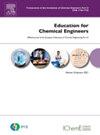STEM activities for heat transfer learning: Integrating simulation, mathematical modeling, and experimental validation in transport phenomena education
IF 2.3
2区 教育学
Q1 EDUCATION, SCIENTIFIC DISCIPLINES
引用次数: 0
Abstract
This communication showcases teaching strategies implemented in a Transport Phenomena course at the undergraduate level to understand heat transfer by conduction, incorporating elements of STEM education (Science, Technology, Engineering, and Mathematics). The educational proposal focused on designing four STEM Workshops under the design-based research methodology. In the first one, interactive simulations were designed using the PDEtool of MATLAB so that the student could visualize the heat transfer phenomenon using color palettes to build the corresponding isotherms. In the second workshop, a hands-on laboratory kit based on ARDUINO was designed in which the student could experimentally validate the studied phenomenon, while in the third workshop, MATLAB was used to visualize the analytical solution of the heat equation. Finally, in a fourth workshop, a detailed mathematical modeling and simulation of the phenomenon was performed using COMSOL. The didactic strategy was evaluated in groups of Transport Phenomena in 2020 (n=42), 2021 (n=40), 2022 (n=21), and 2023 (n=32) terms for engineering students. Through its application, the students understood the basic concepts of computer-assisted process simulation and improved their skills, allowing the implementation of the B-Learning model in the Transport Phenomena course. In all cases, teaching materials, "ready-to-use" codes, and step-by-step instructions have been provided. Readers are invited to use the tools to contribute their evaluations.
传热学习的 STEM 活动:将模拟、数学建模和实验验证整合到传输现象教育中
这篇通讯展示了在本科阶段的 "运输现象 "课程中实施的教学策略,以理解通过传导进行的热传递,其中融入了 STEM 教育(科学、技术、工程和数学)的元素。教育提案的重点是根据基于设计的研究方法设计四个 STEM 讲习班。在第一个讲习班中,使用 MATLAB 的 PDEtool 设计了互动模拟,这样学生就可以使用调色板建立相应的等温线,从而直观地了解传热现象。在第二期讲习班中,设计了基于 ARDUINO 的动手实验套件,学生可以通过实验验证所研究的现象;在第三期讲习班中,使用 MATLAB 可视化热方程的解析解。最后,在第四期讲习班上,使用 COMSOL 对这一现象进行了详细的数学建模和模拟。该教学策略在 2020 年(42 人)、2021 年(40 人)、2022 年(21 人)和 2023 年(32 人)的工科学生运输现象小组中进行了评估。通过应用,学生们理解了计算机辅助过程仿真的基本概念,提高了技能,从而在运输现象课程中实施了B-Learning模式。在所有情况下,都提供了教学材料、"即用型 "代码和分步说明。欢迎读者使用这些工具,并提出自己的评价意见。
本文章由计算机程序翻译,如有差异,请以英文原文为准。
求助全文
约1分钟内获得全文
求助全文
来源期刊

Education for Chemical Engineers
Multiple-
CiteScore
8.80
自引率
17.90%
发文量
30
审稿时长
31 days
期刊介绍:
Education for Chemical Engineers was launched in 2006 with a remit to publisheducation research papers, resource reviews and teaching and learning notes. ECE is targeted at chemical engineering academics and educators, discussing the ongoingchanges and development in chemical engineering education. This international title publishes papers from around the world, creating a global network of chemical engineering academics. Papers demonstrating how educational research results can be applied to chemical engineering education are particularly welcome, as are the accounts of research work that brings new perspectives to established principles, highlighting unsolved problems or indicating direction for future research relevant to chemical engineering education. Core topic areas: -Assessment- Accreditation- Curriculum development and transformation- Design- Diversity- Distance education-- E-learning Entrepreneurship programs- Industry-academic linkages- Benchmarking- Lifelong learning- Multidisciplinary programs- Outreach from kindergarten to high school programs- Student recruitment and retention and transition programs- New technology- Problem-based learning- Social responsibility and professionalism- Teamwork- Web-based learning
 求助内容:
求助内容: 应助结果提醒方式:
应助结果提醒方式:


